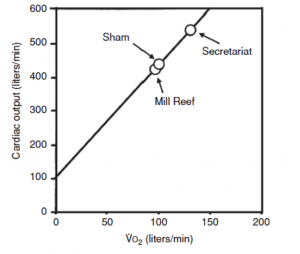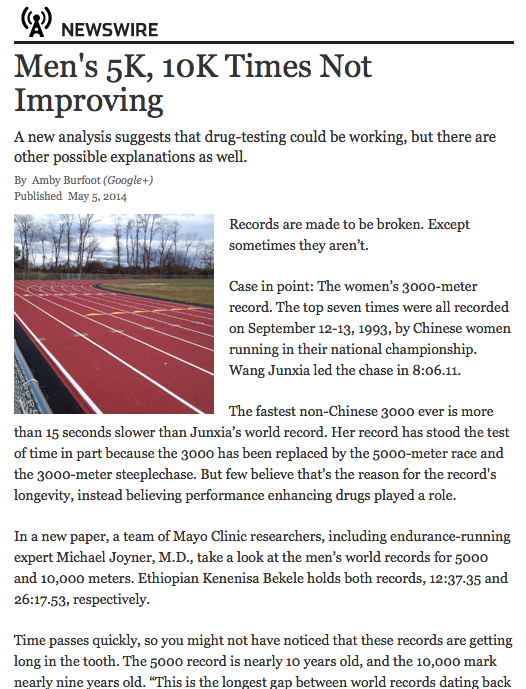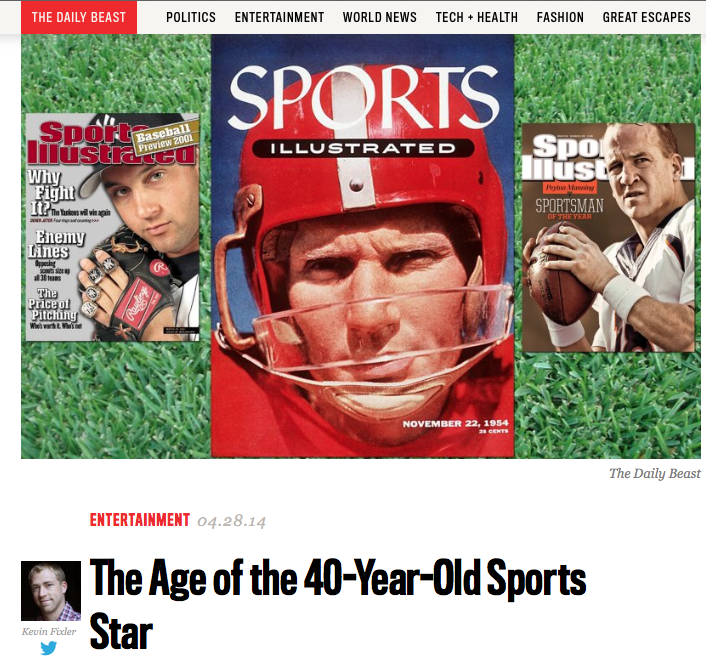Archive for the ‘Elite Sports Performance’ Category
Is Overparenting Soccer’s Grass Ceiling?
The loss by the US to Belgium in the World Cup round of 16 will lead to all sorts of endless speculation about what this means for soccer in the US. As an extremely casual fan who can barely understand why there is not a fixed off-sides line like in ice-hockey, gridiron football, and basketball I think US soccer is a testament to the limits of overparenting. What do I mean?
First, I have been to Brazil and traveled around extensively. In essentially every vacant lot in every neighborhood I saw kids playing pick-up soccer. This was also true in rural areas. Contrast this to the acres of well-manicured fields in suburban America, hyper-organized youth programs, teams named Suburban-United, and minivans galore. The only pick-up games you see are when the immigrant adults show up on Sunday mornings and it is Bosnia vs. Somalia for an hour or two.
Second, drive around “nice” neighborhoods in the US and you see basketball hoops in the drive ways. Have you ever seen a soccer goal? While the NBA is populated by mostly African Americans, it turns out many are not as ghetto as we think. The relentless backyard games played by the Miller family (Reggie and Cheryl) are keys to what made them great players.
Third, all over the country in cities and towns large and small there is “a court” someplace where endless games of pick-up 3 on 3 take place. Everyone interested in becoming a good player knows where this court is and at the better ones you will find a collection of players ranging from solid high-schoolers to people headed to the NBA. Frequently these games have rules like “makers takers”, meaning if you score your team keeps the ball and if your team wins you keep the court. There are no parents, no officials, no fancy uniforms, and no Gatorade on the sidelines. There is also a phenomenon known as “noon-ball” at many YMCAs where in the summer middle aged men give the young guys lessons about holding, hacking, and the finer points of getting an edge. In the parent run world of suburban soccer would this be tolerated? What would happen to Jr’s self-esteem?
Finally, as I watched the US struggle against Belgium to mount attacks I kept asking myself where is the electrifying player who can make it happen? There was no Magic Johnson or Brett Favre to pull it out against long odds the way Lionel Messi did in Argentina’s win over Switzerland in the final minutes. I am also sure that while Magic Johnson and Brett Favre perfected their skills via formal practice, the roots of those skills were developed on playgrounds with no parents around. My bet is that no one drove Magic to the park in a minivan and taught him the no look pass. The paradox of US soccer is maybe that it has to get less organized to get better. Minivans can only go so fast and take you so far.
Dick Fosbury vs. Guidelines
Over the past couple of years I have argued that the current world wide obsession with “big data” and metrics is going to lead all sorts of people astray in many fields. The related idea is that every human activity can be turned into a quality improvement project with guidelines and check boxes that will reduce error and improve outcomes. Taken too far these twin beliefs are going to limit the sort of individual mastery and innovation needed to find novel solutions to our problems.
A couple of months ago I gave a presentation at Mayo where I highlighted the problems of too much standardization in medicine and the risk it poses to better patient care and innovation. I used parallels with the high jumpers Dick Fosbury and Debbie Brill who as teenagers in the 1960s invented the ‘flop’ and went over the bar backwards. In the current world would their efforts have been stifled by a compliance bureaucracy insisting they face the high jump bar while going over? What would the “approval process” for this new technique be in 2014? How many other barriers might be thrown up in the current world to stop them from moving high jumping forward by going backwards?
I explore these and related issues in the talk below. It is a long presentation about 40 minutes, but bear with me and I think you will enjoy the questions and observations raised in the talk.
How the Heat Lost to the Heat
The big news in the first game of the NBA finals was the air conditioning failure in San Antonio. This surely contributed to Lebron James cramping up and being unable to play the final four minutes of the game as the Spurs pulled away.
As the game wore on, ice packs and cold towels were used in an effort to keep the players cooler, and Lebron apparently changed his uniform at half-time to try to cool down. Might there have been a better strategy to deal with a warm and humid environment with a temperature that was apparently in the 90s at game time? The simple answer is yes.
When our core temperature increases a degree or two, the internal thermostat in our brains activates nerves to sweat gland and we start sweating. The internal thermostat also activates nerves that dilate the blood vessels in our skin and blood flow to our skin increases. If the sweat evaporates the skin stays cool and the blood flowing to the skin cools off. This evaporative cooling system lets the heat generated inside the body get out. When we exercise we produce more heat, and this heat transfer system is even more important.
So, the problems for Lebron and his colleagues included the heat they were producing while playing, the temperature in the building and the reduced ability of their sweat to evaporate due to the humidity. All of this then probably his lead to a viscous cycle of higher body temperatures, more sweating and more skin blood with the extra sweating not helping to cool the body but instead causing more fluid losses. Any extra skin blood flow might also have led to less blood flow for the player’s muscles.
So, what might have been done differently? First, wear less clothing. Any observer of the modern NBA can’t fail to notice the extra clothing and gear a lot of the players are wearing. All of this extra swag creates a microenvironment that makes it harder for the sweat to evaporate and cool the skin. So, if happens again Lebron, ditch the tights. Second, forget the ice and cool towels, they may feel good but if they are too cold they might actually reduce skin blood flow and make core temperature higher. Third, get some fans. The key to the evaporative cooling system I described above is evaporating the sweat. My bet is that there were high capacity fans somewhere in the arena and the best strategy would have been to have players take their shirts off on the bench while the fans created the airflow needed to evaporate their sweat and keep them cool and ultimately in the game.
California Chrome Goes For It
Last year prior to the Belmont Stakes I did a post on the great race horse Secretariat who won the Triple Crown in 1973 with the most impressive athletic performance I have ever seen or heard of. This weekend if California Chrome can win the Belmont Stakes, he will be the first horse since 1978 to win the Triple Crown.
Humans vs. Horses
Horses in general and thoroughbred horses in specific are remarkable running machines. Secretariat covered 1.5 miles (about 2413 meters) in the Belmont in 2 minutes and 24 seconds and won by about 30 lengths. When I use a race conversion calculator to estimate how fast a human could run 1.5 miles, here is what I come up with using current world records for men from 800 to 5000 meters and rounding to the second.
Distance Time Estimate for 1.5 miles
800 m 1:40.91 5:25
1000 m 2:11.96 5:35
1500 m 3:26.00 5:41
Mile 3:43.13 5:42
2000 m 4:44.79 5:47
3000 m 7:20.67 5:50
5000 m 12:37.35 5:49
The average of the above estimates is 5:41 meaning that Secretariat covered the distance about 2.4 times as fast as a world class human middle distance runner might.
Maximal Oxygen Uptake
For both humans and horses running really fast for a few minutes requires a high maximal oxygen uptake. This means that the heart has to be able to pump a large amount of blood to the muscles where the oxygen is used to help power the running. The lungs then have to be able to transfer oxygen to the blood as it returns from the muscles. In elite human middle distance runners of 60-70 kgs, the heart can pump somewhere between 30 and 40 liters every minute, and it is not unusual to see such athletes breathing 150 to 200 liters per minute. In these athletes maximal oxygen uptake can be about 80 ml/kg/minute or between about 4.5 and 6 liters per minute when you don’t divide by body weight.
What About Horses?
My colleague David Poole at Kansas State University has done some incredible studies of exercise capacity in race horses. The graph below is from a terrific scientific review article he did with his colleague Howard Erickson on oxygen transport in horses and dogs. The graph shows the estimated cardiac output and oxygen uptake (VO2) in some notable horses. These horses weigh about 500kg so they are about seven or eight times bigger than elite human runners. When you take the numbers off the graph Secretariat had an estimated oxygen uptake of about 130 liters per minute! This value is about 20 times greater than that seen in an elite human runner and means that on a body weight basis it was something like 260 ml/kg/minute — or more than three times the values seen in elite humans. It is also one of the major explanations of why he could run 2.4 times faster than a human. His estimated cardiac output was about 550 liters per minute. For those of you who think in terms of gallons that is almost 150 gallons per minute! Breathing volumes in the range of 2-3000 liters per minute are also possible in these great animals.
When You Watch
When you watch the race this Saturday the horses will be running about 50% faster than Usain Bolt and 24 times as far. The corporate sponsors of the race aside, the race is really being brought to you by Mother Nature, selective breeding and the physiology of oxygen consumption all working together at the outer limits of biology.
How Old is Meb?
The celebration surrounding Meb Keflezighi’s unexpected and inspiring victory at the Boston Marathon a few weeks ago is winding down. Beyond the social significance of his victory, his win at almost 39 years of age raises questions about just how old is “old” at the highest levels of athletic competition. I have been interested in this topic for some time, and whenever an athlete in their late 30s or early 40s does something remarkable my medical colleagues and the media start asking just how unique and exceptional performances by such “old” people are. For example in 2008 there was a wave of interest in this topic when the then 41 year old swimmer Dara Torres was preparing for the Olympics (she won a silver in the 50m freestyle). Here are five thoughts that hopefully can put Meb’s win and age in perspective.
First, some data about Meb’s time at Boston where he ran 2:08:37. This is important because there was a nutty piece in the Wall Street Journal suggesting that a sandbagging conspiracy by the other runners let him win with a slow time. In 1975 Bill Rogers was the first man to run the Boston in less than 2:10. Starting in 75 the winning time has been greater than 2:10 a total of 14 times, between 2:09 and 2:10 twelve times, between 2:08 and 2:09 six times, and faster than 2:08 only 6 times. If you look at the winning times at Boston since 1975, with the exception of a couple of outlier years in 2010 and 2011, they have been remarkably stable and Meb’s time would have won 14 of the last 20 races. Over this time Kenyans and Ethiopians won 18 of 20 races. In 2011 there was also a major tailwind that clearly explains the times in the 2:03s that year. If the over/under betting line at Boston is 2:08 next year, I will bet over.
The second issue is why did the pack let Meb get away and open up a lead via high risk front running? My guess is that many of the top runners did not realize just how fast 2:08 is at Boston, and they figured they could run Meb down later. This is problematic because the first two-thirds of the course is downhill and going downhill for that long that fast takes the snap right out of even the fastest runners legs. There is also precedent for front running in major marathons. Frank Shorter used similar tactics when he won the gold medal at Munich in 1972, and the story of that race is told beautifully by Kenny Moore (the 4th place finisher) in a piece he wrote for Sports Illustrated. My bet is that when he took off and no one chased a sort of groupthink set into the lead pack while they waited for him to fade a few miles down the road.
Third, Meb is not the first fast old guy. The great Ethiopian Mamo Wolde was 36 or 37 when he won gold in 1968 and 40 or 41 when he won the bronze at Munich in 1972. Carlos Lopes won the 1984 Olympic marathon at age 37 and a year later was the first man under 2:08. In the 1970s Jack Foster did well in Olympics in his early 40s and won the Honolulu Marathon at 43. At age 41 he went 2:11 and won a silver medal at the Commonwealth games. The women’s marathon in Bejing was won by 38 year old Constantina Diţă of Romania. The current masters world record is held by Andres Espinosa of Mexico who ran 2:08:46 at age 40 in 2003. All of these performances are remarkable and a 2:08 marathon is the equivalent of a 100m time of about 10 seconds flat or a mile of about 3:51.
Fourth, how is this possible? It turns out the major determinants of distance running performance including maximal oxygen consumption can be remarkably well preserved up to about age 40 and beyond, provided there is an adequate training stimulus including a lot of fast running. Motivation is also a key and the emergence of prize money and sponsorship over the last 20 or 30 years (Meb won $100,000 at Boston) has likely encouraged people to keep training and competing for longer. Improvements in sports medicine also make it easier for people to recover from injuries that were once career ending.
Fifth, don’t forget aging in other sports? When you get beyond distance running all sorts of other examples emerge like Julius Boros winning the PGA golf championship when he was 48, Ted Williams hitting 388 at age 38, and Warren Spahn winning 23 games in the major leagues when he was 42. Randy Johnson pitched a perfect game at age 40. There is also a long list of ice hockey players who have done well in their 40s, and don’t forget about boxers like Archie Moore and Bernard Hopkins who won championships in their late 40s. You can argue that the golf and baseball examples don’t count as much because these sports are more about skill and experience than conditioning, but you have to be in shape to play hockey and box. Incredibly, Chris Horner won the Vuelta a España cycling race at age 42 in 2013. If space were unlimited I could go on and on with examples.
Where will it all end? My guess is that we are going to see the number of people in their late 30s and early 40s who do well at the highest level of sport continue to grow, and it is just a matter of time until someone over 40 wins a major marathon or joins Mamo Wolde with an Olympic medal. It is also just a matter of time until someone over 50 wins a major golf championship (Tom Watson got 2nd at the British Open at age 59 in 2009) or perhaps pitches in and wins a World Series game. As the original ageless athlete Satchel Paige asked, “How old would you be if you didn’t know how old you are?” For Meb Keflezighi, and many others, the answer is we just don’t know.
You are currently browsing the archives for the Elite Sports Performance category.





